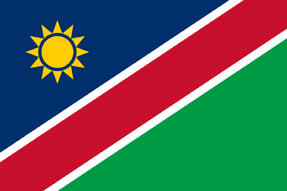The flag of Namibia is divided diagonally from lower hoist corner to upper fly corner by a wide red stripe edged by narrow white stripes; the upper hoist-side triangle is blue and charged with a yellow, 12-rayed sunburst; the lower fly-side triangle is green.[2]
Symbolism[]
- The red represents Namibia's most important resource, its people. It refers to their heroism and their determination to build a future of equal opportunity for all.
- The white refers to peace and unity.
- The green symbolises vegetation and agricultural resources.
- The blue represents the clear Namibian sky and the Atlantic Ocean, the country's precious water resources and rain.
- The golden-yellow sun represents life and energy.[3]
The flag's design is based on the shield in the Namibian coat of arms.
History[]
| In 1884 the territory of the present-day Namibia was placed under protection of the German Empire, and in 1885 Deutsche Kolonialgesellschaft für Südwest-Afrika (German Colonial Company for South-West Africa) was founded, and the country became ruled as a colony of Germany.[4] | |
| In 1914-1915 during the World War I South African troops invaded and occupied the country. After the war, the area came under the control of Britain, and then was made a South African League of Nations mandate. Following the League's supersession by the United Nations in 1946, South Africa refused to surrender its earlier mandate to be replaced by a United Nations Trusteeship agreement. The South Africa never officially incorporated "South-West Africa" into its territory, although it was administered as the de facto "fifth province", with the white minority having representation in the whites-only Parliament of South Africa.[5] | |
| On March 21, 1990, the country proclaimed its independence as the Republic of Namibia and adopted a new flag. Working with the 835 proposals submitted, the National Symbols Sub-Committee of the transitional government met throughout January 1990 and finally approved a flag recommended by South African State Herald Frederick Brownell. That design placed the blue-red-green SWAPO (South West Africa People’s Organization) stripes diagonally and added white fimbriations (narrow borders) on either side of the red to set off the colours. A golden 12-pointed sun was added in the upper hoist corner to represent life and energy.[6] |
References[]
- ↑ NamibWeb.com - The online guide to Namibia: Namibian flag
- ↑ CIA World Factbook
- ↑ Namibia at Flags of the World
- ↑ German South-West Africa at Wikipedia
- ↑ History of Namibia at Wikipedia
- ↑ Namibia, flag of. (2009). In Encyclopædia Britannica. Retrieved January 22, 2009, from Encyclopædia Britannica Online
| Nations States with limited/no recognition Territories |




